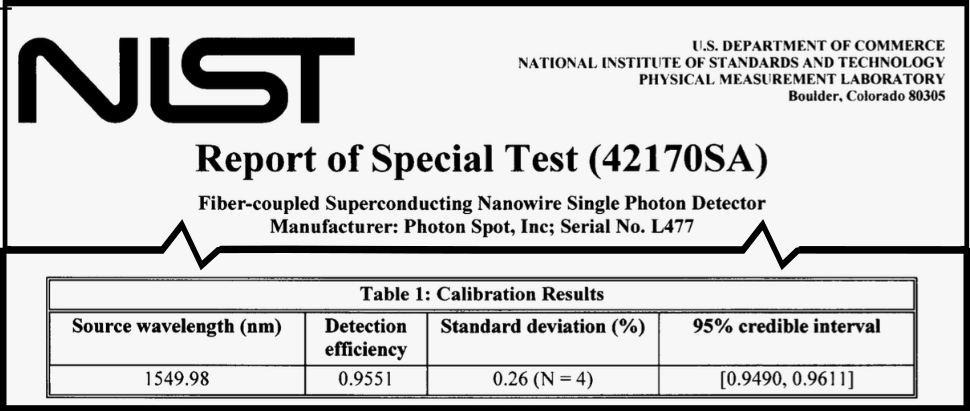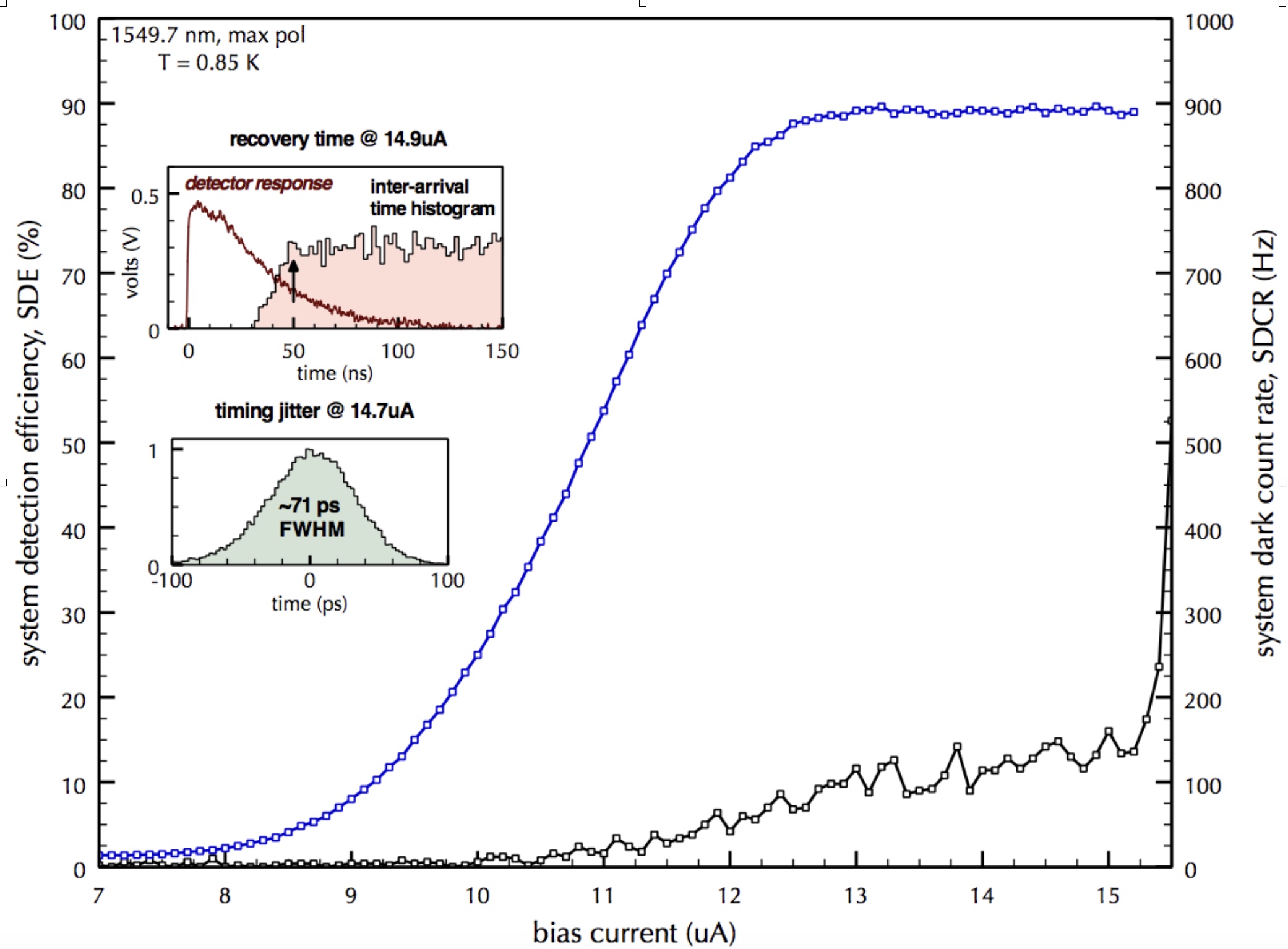single photon detectors
Superconducting nanowire single-photon detectors (SNSPDs) are among the highest performing detectors in the visible and near-infrared frequency range.

system detection efficiency
For fiber-coupled detectors, system detection efficiency (SDE) is defined as the ratio between counted photon events and the signal photons that you wish to detect. SDE includes the efficiency of the optical coupling to the detector, however excludes the insertion loss of the signal photons into the optical fiber.
At Photon Spot, our main focus over the past decade has been on maximizing the efficiency of our detectors, and offering the highest efficiency at your desired wavelength.
We have demonstrated SDE of 95.5% ± 0.6% measured at 1550 nm @ 100 kcps input photon flux.

system dark count rate
The system dark count rate (SDCR) is defined as the response pulse count rate measured when the input fiber to the system is blocked by a shutter.
For SNSPDs, SDCR is dominated by background photons that are generated due to blackbody photons (typically outside the cryostat), which are guided by the optical fiber, and are detected.
We have demonstrated SDCR in the 1 cps - 2 cps range for detectors optimized for 1550nm with a ∼5% degradation in efficiency.

timing jitter
Timing jitter refers to the variability or uncertainty in the precise moment at which a photon is detected. When a photon is incident on a detector, ideally, the detector should register the event at a very specific time. However, due to many factors, the detection time may vary slightly from one detection event to the next. This variation is known as timing jitter. Timing jitter is a critical factor in applications that rely on precise time measurements, such as time-of-flight measurements and for quantum optics experiments.
SNSPDs exhibit a full-width half-maximum timing jitter that can range from tens of picoseconds to hundreds of picoseconds, depending on the length of the meandering wire, superconducting material, SNR, and other factors.
The record for SNSPDs (published by researchers at JPL, NIST, Caltech, and MIT) is sub-3 ps however the efficiency of these detectors was very low.
We have demonstrated timing jitter around 50 ps range for detectors optimized for 1550 nm.

dead time
The dead time, also known as the reset time, is defined as the time it takes for the detector to fully recover for the next photon event.
For SNSPDs, the dead time is proportional to the kinetic inductance of the nanowire (in other words, the length of the nanowire). In other words, it can be challenging to make detectors simultaneously with high efficiency (which would require a larger active area and therefore a longer meandering nanowire) and have a very short dead time.
We have demonstrated dead times around 10 ns for detectors with an SDE of around 70-75% @ 1550 nm. We are working on SNSPDs with even shorter dead times.. stay tuned.
spectral response
The spectral response of our SNSPDs is carefully dialed in via an on-chip optical cavity. The cavity can be designed for broadband operation or for very high efficiencies at narrower bands.
While our most popular detectors are optimized for 1550 nm, we have made detectors that operate at 637nm, 780nm, 825nm, 940nm, 1310nm, and others that were broadband for a wide wavelength range such as 1310-1550nm and 600-900nm.
polarization dependency
SNSPDs tend to have a polarization dependency due to the meandering design of the nanowires.
Most users use polarization controllers (e.g. paddles) to align the polarization when using single-mode fiber to couple to the detector. An alternative is to use polarization maintaining fiber.
maximum count rate & latching
The maximum count rate of SNSPDs can be impacted by the phenomena of latching, where SNSPDs do not fully recover from the normal (resistive) state. This typically occurs at high count rates, often when a detection event occurs while the detector is still recovering from the last detection event.
We offer passive circuits to prevent detectors from latching. We also offer DC-coupled cryogenic amplifiers that can both improve count rates and prevent latching.
detector arrays & photon number resolution
Single-pixel SNSPDs can be formed into imaging arrays (i.e. cameras), which each pixel being individually read out.
In 2024, we delivered a system with a free-space coupled imaging array with 64 pixels.
An alternative to imaging arrays are non-imaging arrays where individual nanowires are arranged in a sub-wavelength pattern. This array can be coupled to an optical fiber and be used to perform photon number resolution (PNR). This kind of PNR is often termed pseudo-PNR because individual elements are not able to clearly distinguish between single photon and multiphoton events, though there can be a slightly different shape to the pulse response.
We have a license to multi-element nanowire detector technology co-invented by our founder while at MIT.
nominal detector specifications
There are trade-offs that prevent achieving peak detector performance in all metrics simultaneously.
We offer the following nominal detector specs, however as we have described above, we are able to tailor and push their limits where allowed by the laws of physics and engineering, of course.
We maintain stock of our most popular detectors, especially at 1550 nm.
SDE
0%or higher
SDCR
0 cpsor lower
dead time
0 nsor lower
timing jitter
0 psor lower
